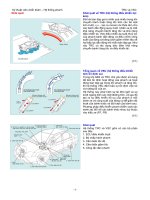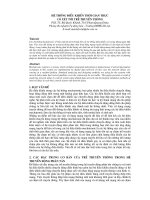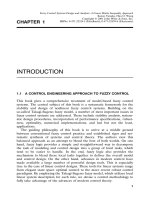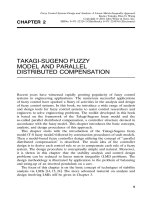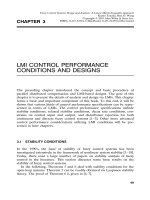Tài liệu Hệ thống điều khiển mờ - Thiết kế và phân tích P7 doc
Bạn đang xem bản rút gọn của tài liệu. Xem và tải ngay bản đầy đủ của tài liệu tại đây (153.8 KB, 11 trang )
Fuzzy Control Systems Design and Analysis: A Linear Matrix Inequality Approach
Kazuo Tanaka, Hua O. Wang
Copyright ᮊ 2001 John Wiley & Sons, Inc.
Ž. Ž .
ISBNs: 0-471-32324-1 Hardback ; 0-471-22459-6 Electronic
CHAPTER 7
ROBUST-OPTIMAL FUZZY CONTROL
wx
This chapter discusses the robust-optimal fuzzy control problem 1᎐3,which
combines robust fuzzy control and optimal fuzzy control. The robust-optimal
fuzzy control problem is useful for practical control system designs that call
for both robustness and optimality. In the last two chapters the robustness
and optimality issues have been addressed separately. This chapter presents a
unified design procedure to address both issues simultaneously to provide
a solution to the robust-optimal fuzzy control problem. A design example is
included to illustrate the merits of robust fuzzy control, optimal fuzzy control,
and robust-optimal fuzzy control. The well-known nonlinear control bench-
mark problem, that is, the translational actuator with rotational actuator
Ž. wx
TORA system 4᎐6,is employed as the design example.
7.1 ROBUST-OPTIMAL FUZZY CONTROL PROBLEM
The robust-optimal fuzzy control design conditions are captured in the
following theorem. Naturally these conditions are rendered by combining
Ž.Ž .
Theorems 23 robust fuzzy control and 25 optimal fuzzy control .
Ž.
THEOREM 28 The PDC controller 2.23 that simultaneously considers both
Ž.
the robust fuzzy controller design Theorem 23 and the optimal fuzzy controller
121
ROBUST-OPTIMAL FUZZY CONTROL
122
Ž.
design Theorem 25 can be designed by sol®ing the following LMIs:
r
22
minimize
q
␣␥
q
␥
Ä4
Ý
iai i bi
22
,
␥
,
␥
, X ,
is1
ai bi
M
,..., M , Y
1
r 0
subject to
X)0, Y G 0,
0
T
x 0
Ž.
) 0,7.1
Ž.
x 0 X
Ž.
ˆ
S q s y 1 Y - 0, i s 1,2,...,r ,
Ž.
ii 1
ˆ
T y 2Y - 0, i - j F r s.t. h l h /
,
ij 2 ij
ˆ
U q s y 1 Y - 0, i s 1,2,...,r ,
Ž.
ii 3
ˆ
V y 2Y - 0, i - j F r s.t. h l h /
,
ij 4 ij
where s ) 1,
T
XA q AX
ii
)) ) )
TT
ž/
yBMy MB
ii ii
T
D yI 00 0
ai
ˆ
S s ,
ii
T
D 0 yI 00
bi
2
EX 00y
␥
I 0
ai ai
2
yEM 00 0 y
␥
I
bi i bi
T
XA
q AX
ii
TT
y
BMy MB
ij ji
TTTTTT
DDDD XE
yME XE yME
ai bi aj bj ai j bi aj i bj
T
q
XA q AX
jj
0
TT
y
BMy MB
ji ij
T
D
yI 000 0 0 0 0
ai
T
D
0 yI 00 0 0 0 0
bi
ˆ
T s
,
T
ij
D
00yI 00 0 0 0
aj
T
D
000yI 0000
bj
2
EX
0000y
␥
I 000
ai ai
2
y
EM 0000 0 y
␥
I 00
bi j bi
2
EX
0000 0 0 y
␥
I 0
aj aj
2
y
EM 0000 0 0 0 y
␥
I
bj i bj
ROBUST-OPTIMAL FUZZY CONTROL PROBLEM
123
Y 0000
Y s block-diag ,
Ž.
0
1
Y 00000000
Y s block-diag ,
Ž.
0
2
T
XA q AX
ii
TT
XC yM
ii
TT
ž/
yBMy MB
ii ii
ˆ
U s ,
ii
y1
CX yW 0
i
y1
yM 0 yR
i
T
XA q AX
ii
TT
yBMy MB
ij ji
TTTT
XC yMXCyM
ijji
T
qXA q AX
jj
0
TT
yBMy MB
ji i j
ˆ
V s ,
ij
y1
CX yW 000
i
y1
yM 0 yR 00
j
y1
CX 00yW 0
j
y1
yM 000yR
i
Y 00
Y s block-diag ,
Ž.
0
3
Y 0000
Y s block-diag ,
Ž.
0
4
Ž.
where the asterisk denotes the transposed elements matrices for symmetric
positions.
Proof. It follows directly from Theorems 23 and 25.
Ž.
Remark 20 As shown in Chapter 3, the condition 7.1 may be replaced with
Ž.
3.56 to handle the uncertainty in initial conditions.
Ž.
When Q s 0 i.e., Y s XQ X , the relaxed conditions are reduced to the
000
following conditions:
r
22
minimize
q
␣␥
q
␥
Ä4
Ý
iai i bi
22
,
␥
,
␥
, X ,
is1
ai bi
M
,..., M
1
r
subject to
X ) 0,
ROBUST-OPTIMAL FUZZY CONTROL
124
T
x 0
Ž.
) 0,
x 0 X
Ž.
ˆ
S - 0, i s 1,2,...,r ,
ii
ˆ
T - 0, i - j F r s.t. h l h /
,
ij i j
ˆ
U - 0, i s 1,2,...,r ,
ii
ˆ
V - 0, i - j F r s.t. h l h /
.
ij i j
Ž.
In the design problem above, the initial conditions x 0 are assumed
known. If not so, the theorem is not directly applicable. In this case, if all the
Ž. Ž.
vertex points x 0 of a polyhedron containing the initial conditions x 0 are
k
known, that is,
l
x 0 s
x 0,
Ž. Ž.
Ý
kk
k
s1
l
n
G 0,
s 1, x 0 g R ,
Ž.
Ý
kkk
k
s1
Theorem 28 can be modified as follows to handle the uncertain initial
conditions.
Ž.
THEOREM 29 The PDC controller 2.23 that simultaneously considers both
Ž.
the robust fuzzy controller design Theorem 23 and the optimal fuzzy control
Ž.
design Theorem 25 can be designed by sol®ing the following LMIs:
r
22
minimize
q
␣␥
q
␥
Ä4
Ý
iai i bi
22
,
␥
,
␥
, X ,
is1
ai bi
M
,..., M , Y
1
r 0
subject to
X)0 Y G 0,
0
T
x 0
Ž.
k
) 0, k s 1,2,...,l,
x 0 X
Ž.
k
ˆ
S q s y 1 Y - 0, i s 1,2,...,r
Ž.
ii 1
ˆ
T y 2Y - 0, i - j F r s.t. h l h /
ij 2 ij
ˆ
U q s y 1 Y - 0, i s 1,2,...,r
Ž.
ii 3
ˆ
V y 2Y - 0. i - j F r s.t. h l h /
ij 4 ij
Proof. It follows directly from Theorem 28.
DESIGN EXAMPLE: TORA
125
Fig. 7.1 TORA system.
7.2 DESIGN EXAMPLE: TORA
Consider the system shown in Figure 7.1, which represents a translational
Ž.wx
oscillator with an eccentric rotational proof mass actuator TORA 4᎐6.
The nonlinear coupling between the rotational motion of the actuator and
the translational motion of the oscillator provides the mechanism for control.
Let x and x denote the translational position and velocity of the cart
12
with x s x . Let x s
and x s x denote the angular position and
˙˙
21 3 43
velocity of the rotational proof mass. Then the system dynamics can be
described by the equation
x s f x q g x u q d,7.2
Ž. Ž. Ž .
˙
where u is the torque applied to the eccentric mass, d is the disturbance, and
x
2
2
yx q
x sin x
143
22
1 y
cos x
3
f x s ,
Ž.
x
4
2
cos xxy
x sin x
Ž.
31 4 3
22
1 y
cos x
3
0
y
cos x
3
22
1 y
cos x
3
g x s ,
Ž.
0
1
22
1 y
cos x
3
s 0.1.
